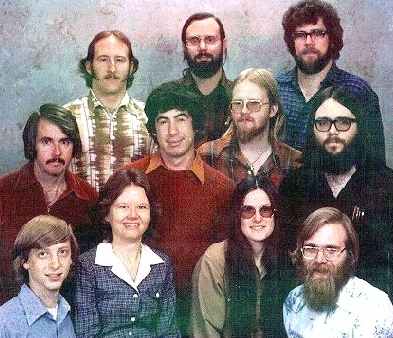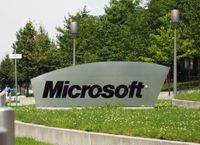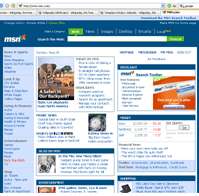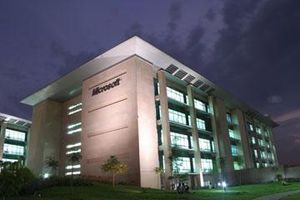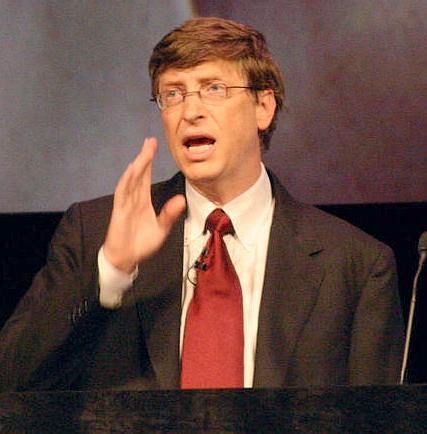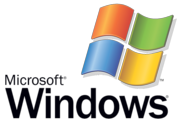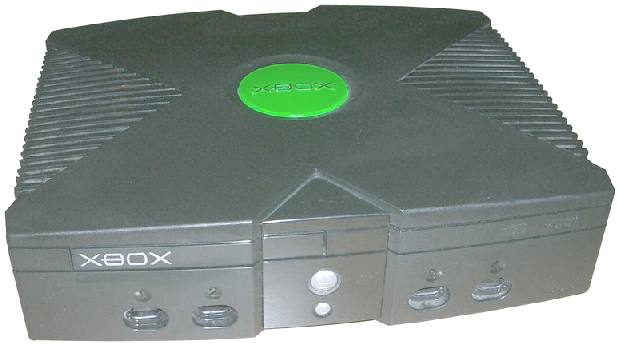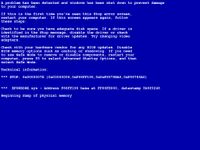|
MICROSOFT
|
|
|
HOME | BIOLOGY | FILMS | GEOGRAPHY | HISTORY | INDEX | MUSIC | THE BOAT | SOLAR BOATS | SPONSORS |
|
|
Microsoft Corporation (NASDAQ: MSFT, SEHK: 4338) is an international computer technology corporation with 2005 global annual sales of close to $40 billion USD and about 64,000 employees in 85 countries and regions which develops, manufactures, licenses, and supports a wide range of software products for computing devices. Headquartered in Redmond, Washington, its most popular products are the Microsoft Windows operating system and the Microsoft Office suite of productivity software, each of which has achieved near ubiquity in the desktop computer market. Microsoft possesses footholds in other markets, with assets such as the MSNBC cable television network, the MSN Internet portal, and the Microsoft Encarta multimedia encyclopedia. The company also markets home entertainment products, such as the Xbox, Xbox 360 and MSN TV.
Microsoft staff Dec 7 1978. Left
to right. Top row: Steve Wood, Bob Wallace, Jim Lane.
Microsoft's name, originally bicapitalized MicroSoft, is a blend of "microcomputer software", and is often abbreviated as MS. The company was founded in Albuquerque, New Mexico on April 4, 1975 by Bill Gates and Paul Allen to develop and sell BASIC interpreters for the Altair 8800. After the market saw a flood of IBM PC clones in the mid-1980s, Microsoft used its new position, which it gained in part due to a contract from IBM, to dominate the home computer operating system market with MS-DOS. The company later released an initial public offering (IPO) in the stock market, which netted several of its employees millions of dollars due to the ensuing rise of the stock price. The price of the stock continued its rise steadily into the early 2000s. In Microsoft Windows, the company was selling what would become the most widely used operating system in the world, which was originally an add-on for MS-DOS; Microsoft continued to push into multiple markets, such as computer hardware and television. In addition, Microsoft has historically given customer support over Usenet newsgroups and the World Wide Web, and awards Microsoft MVP status to volunteers who are deemed helpful in assisting the company's customers.
With what is generally described as a developer-centric business culture, Microsoft has become widely known for some of its internal codes of conduct for its employees. One example is the "eat your own dog-food" mantra, which describes the practice of using pre-release products inside the company to test them in an environment geared towards the real world. Microsoft has also become widely panned for its business practices—the U.S. Justice Department, among others, has sued Microsoft for antitrust violations and software bundling. In addition, Microsoft has been criticized for the insecurity of its software. Despite this, Microsoft has won several awards, such as the "1993 Most Innovative Company Operating in the U.S." by Fortune Magazine. The company is on the Fortune 500 list of companies as of 2005. New for 2007, the Vista operating system appears to be not all that it has been hailed as, and has been slammed as energy hungry, hence due to the number of computer users likely to purchase a copy in all innocence, could become a major contributor to global warming. After his much publicized Trust to fight against poverty, it could be that are paying a very high price indeed in world terms for a small return to good causes. A bit like closing the door after the horse has bolted.
History
1975–1981: The founding of Microsoft
Days after reading the January 1, 1975, issue of Popular Electronics that demonstrated the Altair 8800, Bill Gates called the creators of the new microcomputer, MITS (Micro Instrumentation and Telemetry Systems), offering to demonstrate an implementation of the BASIC programming language for the system. Gates had neither an interpreter nor an Altair system, yet in the eight weeks before the demo he and Allen developed the interpreter. The interpreter worked at the demo and MITS agreed to distribute Altair BASIC. Gates left Harvard University, moved to Albuquerque, New Mexico where MITS was located, and founded Microsoft there. The name Microsoft, without the hyphen, was first used in a letter from Gates to Allen on November 29, 1975, and on November 26, 1976 the name became a registered trademark. The company's first international office was founded on November 1, 1978, in Japan, entitled "ASCII Microsoft" (now called "Microsoft Japan"). On January 1, 1979, the company moved from Albuquerque to a new home in Bellevue, Washington. Steve Ballmer joined the company on June 11, 1980, and would later succeed Bill Gates as CEO. The company restructured on June 25, 1981, to become an incorporated business in its home state of Washington (with a further change of its name to "Microsoft, Inc."). As part of the restructuring, Bill Gates became president of the company and Chairman of the Board, and Paul Allen became Executive Vice President.
Microsoft's first operating system was Xenix, released in 1980. After acquiring a license to distribute Unix from AT&T, Microsoft hired Santa Cruz Operation in order to port/adapt the operating system to several platforms. This operating system was initially used by software maker 3Com (at that time) in order to provide support for the software which implemented the TCP/IP communication protocol. This Unix variant would also become home to the first version of Microsoft's word processor, Microsoft Word. Originally titled "Multi-Tool Word", Microsoft Word became notable for its concept of "What You See Is What You Get", or WYSIWYG, as well as several features including the ability to display bold text, of which it was the first application to do so. First released in the spring of 1983, free demonstration copies of the application were bundled with the November 1983 issue of PC World, making it the first program to be distributed on-disk with a magazine.
1981–1984: Getting power
However, the operating system that brought the company its real success was the DOS operating system. On August 12, 1981, after negotiations with Digital Research failed, IBM awarded a contract to Microsoft to provide a version of the CP/M operating system, which was set to be used in the upcoming IBM Personal Computer (PC). However, Microsoft did not have an operating system at the time, so it purchased a CP/M clone called QDOS (Quick and Dirty Operating System) from Tim Paterson of Seattle Computer Products for $50,000, which Microsoft renamed to PC-DOS. Due to potential copyright infringement problems with CP/M, IBM marketed both CP/M and PC-DOS for $250 and $40, respectively, with PC-DOS eventually becoming the standard because of its lower price. Around 1983, in collaboration with numerous companies, Microsoft created a home computer system, MSX, which contained its own version of the DOS operating system, entitled MSX-DOS; this became relatively popular in Japan and Europe. Later, after Compaq successfully cloned the IBM BIOS, the market saw a flood of IBM PC clones. Microsoft was quick to use its position to dominate the home computer operating system market. Microsoft began licensing its operating system for use on non-IBM PC clones, and called this version of the operating system MS-DOS (short for Microsoft Disk Operating System). By marketing MS-DOS aggressively to manufacturers of IBM-PC clones, Microsoft rose from a small player to one of the major software vendors in the home computer industry. Starting on May 2, 1983, with the "Microsoft Mouse", Microsoft entered markets such as computer hardware. This expansion included Microsoft Press, a book publishing division, on November 10 the same year, which debuted with two titles: "Exploring the IBM PC Home Computer" by Peter Norton, and "The Apple Macintosh Book" by Cary Lu.
1985–1991: The rise and fall of OS/2
The Republic of Ireland became home to Microsoft's first international production facility in 1985, and on November 20 Microsoft released its first retail version of Microsoft Windows, originally a graphical extension for its MS-DOS operating system. In August, Microsoft and IBM partnered in the development of a different operating system called OS/2. OS/2 was marketed in connection with a new hardware design proprietary to IBM, the PS/2. Shortly afterwards on February 16, 1986, Microsoft relocated to Redmond, Washington. Around one month later, on March 13, the company went public with an IPO, raising $61 million at $21.00 per share. By the end of the trading day, the price had risen to $28.00. In 1987, Microsoft eventually released their first version of OS/2 to OEMs.
Meanwhile, Microsoft began introducing its most prominent office products. Microsoft Works, an integrated office program which combined features typically found in a word processor, spreadsheet, database and other office applications, saw its first release as an application for the Apple Macintosh towards the end of 1986. Microsoft Works would later be sold with other Microsoft products including Microsoft Word and Microsoft Bookshelf, a reference collection introduced in 1987 that was the company's first CD-ROM product. Later, on August 8, 1989, Microsoft would introduce its most successful office product, Microsoft Office. Unlike the model of Microsoft Works, Microsoft Office was a bundle of Microsoft's other office separate productivity applications, such as Microsoft Word, Microsoft Excel and so forth. While Microsoft Word and Microsoft Office were mostly developed internally, Microsoft also continued its trend of rebranding products from other companies, such as SQL Server on January 13, 1988, a relational database management system for companies that was based on technology licensed from Sybase.
In 1989, Microsoft announced at Comdex that the 1991 release of Windows 3.0 would be the last version of Windows. Over the next few years, Microsoft continued to issue statements indicating that OS/2 was the future of computing. On May 16, 1991, Bill Gates announced to Microsoft employees that the OS/2 partnership was over, and that Microsoft would henceforth focus its platform efforts on Windows and the Windows NT kernel. Some people, especially developers who had ignored Windows and committed most of their resources to OS/2, were taken by surprise, and accused Microsoft of deception. The Windows changeover was frequently referred to in the industry as "the head-fake". In the ensuing years, the popularity of OS/2 declined, and Windows quickly became the favored PC platform. 1991 also marked the founding of Microsoft Research, an organization in Microsoft for researching computer science subjects, and Microsoft Visual Basic, a popular development product for companies and individuals.
German Microsoft campus, Konrad-Zuse-Str. 1, Unterschleißheim, Germany Microsoft is an international company with offices in many countries
1992–1995: Domination of the corporate market
During the transition from MS-DOS to Windows, the success of Microsoft's product Microsoft Office allowed the company to gain ground on application-software competitors, such as WordPerfect and Lotus 1-2-3. Some allege that Microsoft used its inside knowledge of the DOS and Windows kernels and of undocumented Application Programming Interface features to make Office perform better than its competitors, but internal sources at Microsoft later revealed that the Office team did not have access to the Windows source code at the time, and relied on reverse engineering.
Eventually, Microsoft Office became the dominant business suite, with a market share far exceeding that of its competitors. In March 1992, Microsoft released Windows 3.1 along with its first promotional campaign on TV; the software sold over three million copies in its first two months on the market. In October, Windows for Workgroups 3.1 was released with integrated networking capabilities such as peer-to-peer file and printing sharing. In November, Microsoft released the first version of their popular database software Microsoft Access. By 1993, Windows had become the most widely used GUI operating system in the world. Fortune Magazine named Microsoft as the "1993 Most Innovative Company Operating in the U.S.". The year also marked the end of a five-year legal case brought by Apple, dubbed Apple Computer, Inc. v. Microsoft Corp., in which the ruling was in Microsoft's favor. That same year, Microsoft released Windows for Workgroups 3.11, a new version of the consumer line of Windows, and Windows NT 3.1, a server-based operating system with a similar user interface to consumer versions of the operating system, but with an entirely different kernel.
As part of its strategy to broaden its business, Microsoft released Microsoft Encarta in 1994, the first encyclopedia designed to run on a computer. Microsoft also created the Microsoft Plus product support program for its customers, a service that offered cost savings on Microsoft products. The name of that program was later used for several expansion packs for Windows. The company changed its slogan to "Where do you want to go today?" in that year, as part of an attempt to appeal to nontechnical audiences in a US $100 million advertising campaign, which some critics regarded as uninspired. Dreamworks SKG and Microsoft formed a new company, Dreamworks Interactive, to produce interactive and multimedia entertainment properties in 1995. In March, Microsoft released Microsoft Bob, a Windows 3.1 program manager replacement, which is widely considered Microsoft's most unsuccessful product; its unpopularity became the source of many jokes.
Up until 1995, Microsoft was a business-oriented company. However, in August 1995, it released a new version of its flagship software, Microsoft Windows 95, with a completely new user interface, including a novel start button; more than a million copies of Microsoft Windows 95 were sold in the first four days after its release. The new version of Windows was the start of a major transition towards a consumer-oriented company. In September, the Chinese government chose Windows to be the operating system of choice in that country, and entered into an agreement with the Company to standardize a Chinese version of the operating system. Microsoft also released the Microsoft Sidewinder 3D Pro joystick in an attempt to further expand its profile in the computer hardware market.
|
|
We specialise in the design and manufacture of electronic assemblies, a few examples of which are:
Qtronics can be contacted at the telephone numbers or email addresses below:
Office: +44 (0) 161 408 0917
Mob.: +44 (0) 7725615079 FAX: 0033321817086
Emaill: sales@qtronics.net or tech@qtronics.net
|
User culture
Technical reference for developers and articles for various Microsoft magazines such as Microsoft Systems Journal (or MSJ) is available through Microsoft's MSDN site, short for Microsoft Developer Network. MSDN also offers subscriptions for companies and individuals, and the more expensive subscriptions usually offer access to pre-release beta versions of Microsoft software. In recent years, Microsoft launched a community site for developers and users, entitled Channel9, which provides many modern features such as a wiki and an Internet forum.
Most free technical support available through Microsoft is provided through online Usenet newsgroups (in the early days it was also provided on Compuserve). There are several of these newsgroups for nearly every product Microsoft provides, and often they are monitored by Microsoft employees. People who are helpful on the newsgroups can be elected by other peers or Microsoft employees for Microsoft Most Valuable Professional (MVP) status, which entitles people to a sort of special social status, in addition to possibilities for awards and other benefits.
Corporate affairs
Corporate structure
The company is run by a Board of Directors consisting of ten people, made up of mostly company outsiders (as is customary for publicly traded companies). Current members of the board of directors of Microsoft are: Steve Ballmer, James Cash, Jr., Dina Dublon, Bill Gates, Raymond Gilmartin, Ann Korologos, David Marquardt, Charles Noski, Helmut Panke, and Jon Shirley. The ten board members are elected every year at the annual shareholders' meeting, and those who do not get a majority of votes must submit a resignation to the board, which will subsequently choose whether or not to accept the resignation. There are five committees within the board which have oversight over more specific matters. These committees include the Audit Committee, which handles accounting issues with the company including auditing and reporting; the Compensation Committee, which approves compensation for the CEO and other employees of the company; the Finance Committee, which handles financial matters such as proposing mergers and acquisitions; the Governance and Nominating Committee, which handles various corporate matters including nomination of the board; and the Antitrust Compliance Committee, which attempts to prevent company practices from violating antitrust laws.
There are several other aspects to the corporate structure of Microsoft. For worldwide matters there is the Executive Team, made up of sixteen company officers across the globe, which is charged with various duties including making sure employees understand Microsoft's culture of business. The sixteen officers of the Executive Team include the Chairman and Chief Software Architect, the CEO, the General Counsel and Secretary, the CFO, senior and group vice presidents from the business units, the CEO of the Europe, the Middle East and Africa regions; and the heads of Worldwide Sales, Marketing and Services; Human Resources; and Corporate Marketing. In addition to the Executive Team there is also the Corporate Staff Council, which handles all major staff functions of the company, including approving corporate policies. The Corporate Staff Council is made up of employees from the Law and Corporate Affairs, Finance, Human Resources, Corporate Marketing, and Advanced Strategy and Policy groups at Microsoft. Other Executive Officers include the Presidents and Vice Presidents of the various product divisions, leaders of the marketing section, and the CTO, among others.
Stock
When the company debuted its IPO in March 12, 1986, the stock price was $22. By the close of the first trading day, the stock had closed at twenty-eight dollars, or 97c, compared with the time period after the company's first nine splits. The initial close and ensuing rise in subsequent years made several Microsoft employees millions. The stock price peaked in 1999 at around $119 ($60.928 adjusting for splits). While the company has had nine stock splits, the first of which was in September 18, 1987, the company did not start offering a dividend until January 16, 2003. The dividend for the 2003 fiscal year was eight cents per share, followed by a dividend of sixteen cents per share the subsequent year. The company switched from yearly to quarterly dividends in 2005, for eight cents a share per quarter with a special one-time payout of three dollars per share for the second quarter of the fiscal year.
Around 2003 the stock price began a slow descent that continued through 2005. The company had its ninth split on February 2, 2003, in what could have been an attempt to arouse interest in the stock, but the price continued to stagnate regardless. On the September 23, 2005, episode of CNBC's Mad Money, the host of the show, Jim Cramer, called Microsoft's stock "the most hated stock on Wall Street".
Diversity
In 2005, Microsoft received a 100% rating in the Corporate Equality Index from the Human Rights Campaign relating to its policies concerning LGBT (lesbian, gay, bisexual and transsexual) employees. Through the work of the Gay and Lesbian Employees at Microsoft (GLEAM) group and Diversity, Microsoft added gender expression to its antidiscrimination policies in April 2005, and the Human Rights Campaign upgraded Microsoft's Corporate Equality Index from its 86% rating in 2004 to its current 100% rating, putting it among the most progressive companies in the world.
In April 2005, Microsoft received wide criticism for withdrawing support from Washington State's H.B. 1515 bill that would have extended the state's current antidiscrimination laws to people with alternate sexual orientations, although some claim they never withdrew support and instead simply were neutral on the bill. However, under harsh criticism from both outside and inside the company's walls, Microsoft decided to support the bill again in May 2005.
Even though it hires many domestic American workers, Microsoft generally goes up to the annual limit in hiring foreign workers with H1B visas. Bill Gates has criticized Congress for the cap on the H1B visas, which he claims makes it difficult to hire employees for the company. Proponents of the cap cite economic and security reasons for the current law. Microsoft was also named one of the 100 Best Companies for Working Mothers in 2004 by Working Mother magazine.
![]()
Microsoft logo, mid-1980s
LOGO
In 1987, Microsoft adopted its current logo, the so-called "Pacman Logo" designed by Scott Baker. According to the March 1987 Computer Reseller News Magazine, "The new logo, in Helvetica italic typeface, has a slash between the o and s to emphasize the "soft" part of the name and convey motion and speed." Dave Norris, a Microsoft employee, ran an internal joke campaign to save the old logo, which was green, in all uppercase, and featured a fanciful letter O, nicknamed the blibbet, but it was discarded.
Criticisms
General
Microsoft has been the focus of much controversy in the computer industry, especially since the 1980s, most critically for its business tactics, which some perceive as unfair and anticompetitive. Often, these practices are described with the term "embrace, extend and extinguish", in which Microsoft initially embraces and extends a competing standard or product, only to later extinguish it through such actions as writing their own incompatible version of the software or standard. These and other tactics have led to Microsoft being convicted by U.S. courts of being an abusive monopoly on at least one occasion, as well as lawsuits by various companies and governments, with varying degrees of success.
Microsoft has also been called a "velvet sweatshop" in reference to allegations of the company working its employees to the point where it might be bad for their health. The first instance of the term in reference to Microsoft originated from a Seattle Times article in 1989, and later became used to describe the company by some of Microsoft's own employees.
Free software proponents and other critics point to the company's "Trustworthy Computing" initiative as a cause of concern, a proposal to increase security and privacy in computing that some speculate will allow software developers to enforce any sort of client-side restriction they wish over their software. Critics also point to Microsoft's use of Digital Rights Management, technology designed to provide content and software providers the ability to put restrictions on how their products are used on their customer's machines.
Blue screen of death in Windows 2000, encountered when Windows cannot (or is in danger of being unable to) recover from a system error
Technical difficulties
Microsoft products are often characterized as being unstable — versions of Windows based on MS-DOS, and later the Windows 95 kernel, were widely panned for their instability, displaying the infamous "Blue screen of death", sometimes known as a BSoD, or abruptly terminating applications at what some consider arbitrary times. However, the adoption of the NT kernel in consumer versions of Windows are widely considered to have improved the operating system's stability, but complaints still arise. Computer users not familiar with the division of responsibilities among applications, the operating system, and third-party device drivers sometimes blame Microsoft for problems that are created by third-party software.
Some accuse Microsoft of allowing the user interface of its products to become inconsistent and overly complicated, requiring interactive "wizards" to function as an extra layer between the user and the interface. The security of Microsoft products (such as Internet Explorer) is also questioned by some as being overly vulnerable to computer viruses and malicious attacks. In addition, proponents of open source are engaged with Microsoft in a debate over the Total cost of ownership (TCO) of its products, as some perceive Microsoft software as more expensive to purchase, use and maintain than competitors' software.
LINKS and REFERENCES
-
Introduction and Infobox
-
Product divisions
-
History
-
Microsoft history at the History of Computing Project (Part 2).
-
Jim Clark; Owen Edwards (1999). Netscape Time: The Making of the Billion Dollar Start-up That Took on Microsoft, Saint Martin's Press. ISBN 0312199341.
-
Michael A. Cusumano; Richard W. Selby (1995). Microsoft Secrets: How the World's Most Powerful Software Company Creates Technology, Shapes Markets and Manages People, Free Press. ISBN 0684855313.
-
Business culture
-
Charles, John. "Indecent proposal? Doing Business With Microsoft". IEEE Software (January/February 1998): 113-117.
-
Jennifer Edstrom; Marlin Eller (1998). Barbarians Led by Bill Gates: Microsoft from inside, N.Y. Holt. ISBN 0805057544.
-
Fred Moody (1995). I Sing the Body Electronic: A Year With Microsoft on the Multimedia Frontier, Viking. ISBN 0670848751.
-
Microsoft's Top 10 New Year's Resolutions for IT Organizations.
-
-
Stock
-
Corporate Structure
Footnotes
-
A. Allen, Roy (October 2001). A History of the Personal Computer: The People and the Technology, 1st edition, Allan Publishing. ISBN 0968910807.
-
Chen, Raymond, "What about BOZOSLIVEHERE and TABTHETEXTOUTFORWIMPS?", The Old New Thing, 16 October 2003.
-
Bob Trott. "Microsoft pondering legal challenge to Linux", CNN, 1998-11-06.
-
Homepage at the United States Department of Justice
-
Microsoft Visual Studio Code Name “Orcas” Community Technology Preview.
-
Microsoft's Team Foundation Server represents a shift to collaborative-centric focus.
-
Announcement of group reorganization intro three core divisions.
-
Mark, Paul, "Gates Rakes Congress on H1B Visa Cap", Various, 27 April 2005.
-
Andrews, Paul, "A 'Velvet Sweatshop' or a High-Tech Heaven?", The Seattle Times, 23 April 1989.
-
Microsoft
-
Microsoft - 'Official website'
-
Microsoft Worldwide Home - 'International Portal'
-
Microsoft Update - 'Official update site'
-
Microsoft Security Bulletins - 'Official security update site'
-
Microsoft UK - 'Microsoft United Kingdom'
-
-
General
-
Yahoo! Finance - 'Microsoft Corporation Company Profile'
-
Microsoft Monitor - 'News, research and analysis from Jupiter Research'
-
Microsoft Versus - 'Dissecting Microsoft'
-
Conference call transcripts - 'Microsoft's most recent conference call transcripts'
-
CNN - 'Microsoft CEO before the US Congress (includes audio)'
-
Yahoo! News - 'Video of Microsoft Antitrust case'
-
Arcon5 - 'Microsoft News'
-
-
Miscellaneous
-
Google Special Search: Microsoft - "Search Microsoft-related pages"
-
Techbooksforfree.com - 'Collection of free downloadable books available from Microsoft'
-
MessagingTalk.org - 'Microsoft Exchange Resource Portal'
-
Partners.Microsoft.com - 'Microsoft Partner Resource Portal'
-
Further reading
-
G. Pascal, Zachary (1994). ShowStopper!, The Free Press. ISBN 0029356717.
![]()
Good for you and the planet
Solar Red | Solar Cola | Solar Crush | Solar Citrus | Solar Spice
This material and any views expressed herein are provided for information purposes only and should not be construed in any way as a prospectus or offer. Please contact the company concerned for information of any business opportunity or specific program. Before investing in any business, you must obtain, read and examine thoroughly its disclosure document or offering memorandum.
This
website
is Copyright © 1999 & 2007 NJK. The bird ![]() logo and name Solar Navigator are trademarks. All rights reserved.
All other trademarks are hereby acknowledged.
Max Energy Limited is
an educational charity.
logo and name Solar Navigator are trademarks. All rights reserved.
All other trademarks are hereby acknowledged.
Max Energy Limited is
an educational charity.
AUTOMOTIVE | BLUEBIRD | ELECTRIC CARS | ELECTRIC CYCLES | SOLAR CARS
